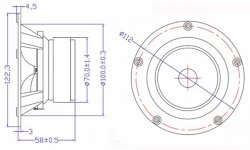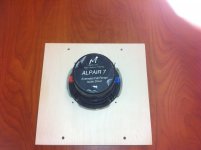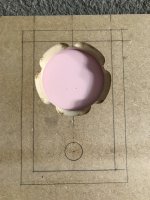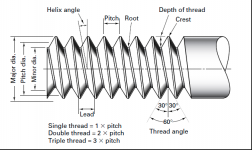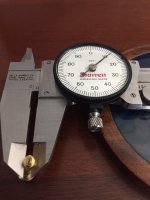I'm working on my first speaker build and studying how to install the drivers. The drivers are Markaudio Pluvia 7 (Markaudio Alpair-7 Gold Cone 4" Full Range) and I plan on surface mounting them in particle board enclosures that are about 5/8" (16.5mm) thick. The dimensions look like they call for a 100mm diameter hole and then the screws are 6mm out from there (on a 112mm diameter circle).
My concern is that if I follow the recommendation from the plans and chamfer the back of the hole at 45 degrees then there will be at most a 6mm thickness of particle board where the screws are going in. That seems like not very much particle board to be screwing into. This post suggests that they are M3 screws.
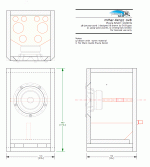
Am I missing something because I'm new at this? Does everybody do it this way and it's just not a problem? I'm planning to make the chamfer with a file, so I could conceivably leave the full thickness around the screw holes, but I'm not sure if that's sonically acceptable. If it wasn't a speaker, I'd use some adhesive to help take some of the weight off those screws, but again I'm too new to know if that's okay.
Thanks for any help you can offer the new guy.
-Neil N0FN
My concern is that if I follow the recommendation from the plans and chamfer the back of the hole at 45 degrees then there will be at most a 6mm thickness of particle board where the screws are going in. That seems like not very much particle board to be screwing into. This post suggests that they are M3 screws.

Am I missing something because I'm new at this? Does everybody do it this way and it's just not a problem? I'm planning to make the chamfer with a file, so I could conceivably leave the full thickness around the screw holes, but I'm not sure if that's sonically acceptable. If it wasn't a speaker, I'd use some adhesive to help take some of the weight off those screws, but again I'm too new to know if that's okay.
Thanks for any help you can offer the new guy.
-Neil N0FN
Last edited:
I'm a firm believer that this is very important with shallow mounting depth / cone profile FR drivers, and have been doing it for at least 15 years.
This could be an opportunity to espouse use of high quality BB or equivalent plywood - which has far better screw retaining qualities that close to edge of driver opening, but as GASCo notes above, you can scallop the chamfer around the screw locations.
In the case of Fostex or other makes/designs with square or pincushion shaped metal frames, the screw locations are generally on a larger radius which will generally leave enough material core that the scalloping as seen in photo below is not so critical .
This could be an opportunity to espouse use of high quality BB or equivalent plywood - which has far better screw retaining qualities that close to edge of driver opening, but as GASCo notes above, you can scallop the chamfer around the screw locations.
In the case of Fostex or other makes/designs with square or pincushion shaped metal frames, the screw locations are generally on a larger radius which will generally leave enough material core that the scalloping as seen in photo below is not so critical .
Attachments
Particle board is very different from plywood when we talk about screw holding.
GASCo’s suggestion is spot on and you might well consider using threaded inserts (not T-Nuts which tend to come loose especially in particle board).
Particle board will not allow for removing the driver and putting it back in very many times — i have seen boxes with many screw holes, as one rotates the drivers to get freash wood to screw into.
dave
GASCo’s suggestion is spot on and you might well consider using threaded inserts (not T-Nuts which tend to come loose especially in particle board).
Particle board will not allow for removing the driver and putting it back in very many times — i have seen boxes with many screw holes, as one rotates the drivers to get freash wood to screw into.
dave
GASCo’s suggestion is spot on and you might well consider using threaded inserts (not T-Nuts which tend to come loose especially in particle board).
Particle board will not allow for removing the driver and putting it back in very many times — i have seen boxes with many screw holes, as one rotates the drivers to get freash wood to screw into.
Sounds like a plan everyone. I'll scallop the chamfer around the screw holes as in Chris's picture and use threaded inserts as well. The particle board's a necessary constraint on this project, unfortunately.
Does anyone know if a #8 or #10 (or 1/4"!?) screw will fit through the mounting holes on that driver? I didn't see anything in the part drawing that suggests what the diameter of the mounting holes is.
-Neil N0FN
There are special tools for inserting threaded inserts, but a trick i used to use for t-nuts might work. Chris?
Using a bolt screw and a washer i would pull the nut into place by tightening up the bolt. This ensures it is pulled up straight and the tangs were fully seated. I’d still get an occasional failure in the field and it can be really tough to remove if the t-nut spun loose. A threaded insert is threaded so this may not work.
dave
Using a bolt screw and a washer i would pull the nut into place by tightening up the bolt. This ensures it is pulled up straight and the tangs were fully seated. I’d still get an occasional failure in the field and it can be really tough to remove if the t-nut spun loose. A threaded insert is threaded so this may not work.
dave
Threaded inserts can be difficult to screw into particle board cleanly though so practice some scrap first
I think the screws needed are m3 so 3mm dia
bingo - I've said this before, I think the screws supplied with the drivers are excellent. They are not a tapered wood screw, but more like a coarse thread constant diameter shank sheet metal screw, and definitely benefit from carefully sized pilot hole and pre-tapping of the screw. The issue with threaded inserts is that the hole required for the external threads is much larger than the screw size, and as the margins are already tight to the driver hole on the smaller drivers such as 70mm class and lower, there's not a lot of core integrity left on plywood, and particle board / MDF is far worse in that regard.
It's more important that you drill a pilot hole that is the same diameter as the pitch diameter of the screw being used. Use a caliper to measure the screw thread root diameter, drill a hole no bigger than the size measured and screw your fastener into the wood. You still have some of the fastener length used by the thickness of the speaker flange, even with the chamfer of the flange, that's more than enough material.
I did these yesterday by eye. Took me a couple of goes and dusty eyes but I got it!
Is there a method to routing the back-chamfer "petals" or do you just eyeball it? I imagine it's probably easier with a router table than freehanding with a plunge router...
Attachments
I'm not so keen on them as I'm an mdf user. What screws would be best for mdf that you'd recommend?
On my build I want to get the drivers in and out a good few times... hmmmmmmm.
On my build I want to get the drivers in and out a good few times... hmmmmmmm.
bingo - I've said this before, I think the screws supplied with the drivers are excellent. They are not a tapered wood screw, but more like a coarse thread constant diameter shank sheet metal screw, and definitely benefit from carefully sized pilot hole and pre-tapping of the screw. The issue with threaded inserts is that the hole required for the external threads is much larger than the screw size, and as the margins are already tight to the driver hole on the smaller drivers such as 70mm class and lower, there's not a lot of core integrity left on plywood, and particle board / MDF is far worse in that regard.
@planet10
I've been using T-nuts for years and have not had one come loose, a little dab around the nut with PVA glue doesn't hurt though. Why would a T-nut come loose when it is under tension from the retaining screw?not T-Nuts which tend to come loose especially in particle board
Wondering about this too. I like to test out my cabinets before painting them, but I'm worried about chewing up the MDF with repeated screw-ins.I'm not so keen on them as I'm an mdf user. What screws would be best for mdf that you'd recommend?
On my build I want to get the drivers in and out a good few times... hmmmmmmm.
Most drivers I've worked with seem to have ~10 mm of bezel for the flush recessed mounting, which isn't a lot of material to fit a threaded insert into.
I'm going to try the above suggestion of hardwood dowels in my current project!
Wondering about this too. I like to test out my cabinets before painting them, but I'm worried about chewing up the MDF with repeated screw-ins.
Most drivers I've worked with seem to have ~10 mm of bezel for the flush recessed mounting, which isn't a lot of material to fit a threaded insert into.
If you drill the correct sized hole for the screw, there is no need to install inserts or dowels. I've replaced speaker drivers several times in MDF speaker cabinets. The screws don't come loose.
Measure the minor diameter of the screw (the bottom of the threads) with a vernier caliper.
The #4 brass wood screw shown has a minor diameter of 0.111". That is a #34 drill. Drill the 0.111" hole to the depth desired. You'll be able to remove and reinstall the screw into the speaker cabinet several times.
If you're planning to build the speaker cabinets for space flight and subject the speakers to 9 G's and above, remove the drivers from the cabinet dozens of times when preparing for the next flight, then maybe an insert or hardwood dowels would be a good idea.
Measure the minor diameter of the screw (the bottom of the threads) with a vernier caliper.
The #4 brass wood screw shown has a minor diameter of 0.111". That is a #34 drill. Drill the 0.111" hole to the depth desired. You'll be able to remove and reinstall the screw into the speaker cabinet several times.
If you're planning to build the speaker cabinets for space flight and subject the speakers to 9 G's and above, remove the drivers from the cabinet dozens of times when preparing for the next flight, then maybe an insert or hardwood dowels would be a good idea.
Attachments
Ok, thanks, I'll try that!
I too have removed drivers from cabs over and over in MDF but the Mark Audio screws are a little different from the regular course pitch thread screws I usually use.
I too have removed drivers from cabs over and over in MDF but the Mark Audio screws are a little different from the regular course pitch thread screws I usually use.
If you drill the correct sized hole for the screw, there is no need to install inserts or dowels. I've replaced speaker drivers several times in MDF speaker cabinets. The screws don't come loose.
Measure the minor diameter of the screw (the bottom of the threads) with a vernier caliper.
The #4 brass wood screw shown has a minor diameter of 0.111". That is a #34 drill. Drill the 0.111" hole to the depth desired. You'll be able to remove and reinstall the screw into the speaker cabinet several times.
If you're planning to build the speaker cabinets for space flight and subject the speakers to 9 G's and above, remove the drivers from the cabinet dozens of times when preparing for the next flight, then maybe an insert or hardwood dowels would be a good idea.
- Status
- This old topic is closed. If you want to reopen this topic, contact a moderator using the "Report Post" button.
- Home
- Design & Build
- Construction Tips
- Chamfering surface-mount drivers?
